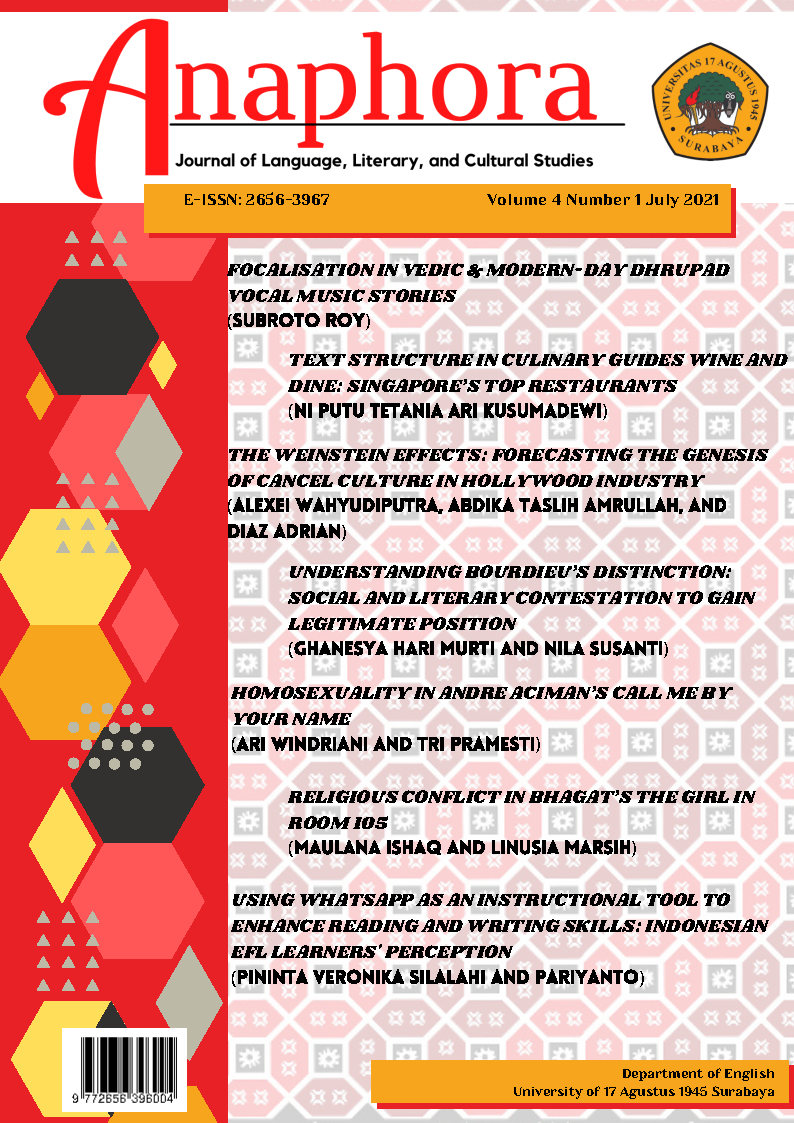HOMOSEXUALITY IN ANDRE ACIMAN’S CALL ME BY YOUR NAME
DOI:
https://doi.org/10.30996/anaphora.v4i1.5250Keywords:
queer criticism, sexual orientation, homosexualityAbstract
This study discusses about Elio’s homosexuality in Andr? Aciman’s Call Me by Your Name. Elio is the main character in the novel. The study aims to answer three points: the cause of Elio’s homosexuality, the effect of Elio’s homosexuality and how homosexuality presented in the novel. The study uses qualitative research because it provides understanding into the problem and it derives meanings from the quotations. This study applies intrinsic and extrinsic approaches. The extrinsic approach used is psychological approach as the literary approach. The psychological approach is applied in causes and effects of homosexuality as a psychological issue. The data source of this study is Call Me by Your Name novel by Andr? Aciman. The study found that Elio’s homosexuality is caused by Elio’s hormone and Elio’s family life. Elio’s desire and lust brings him to the wild imagination and fantasy. Elio’s parents are open-minded. It can be concluded that from the causes of Elio’s homosexuality brings him to the taboo thing and not every people can accept that sexual orientation. The novelist, Andr? Aciman wants to presented about the true feeling of the taboo love.Downloads
References
Aini, N. R. V. & Wahyuni, A. (2018). Pengaruh Penerapan Absensi Fingerprint Dan Budaya Kerja Terhadap Disiplin Kerja Karyawan. 1–18.
Akrom Zulhij Fajri, F., & Mauludin, M. S. (2020). Rancang Bangun Sistem Keamanan Aliran Listrik Arus AC dengan Fingerprint menggunakan Arduino Nano. Jurnal Informatika Dan Rekayasa Perangkat Lunak, 2(1), 26. https://doi.org/10.36499/jinrpl.v2i1.3189
Alimasi, R. (2019). SISTEM PENGAMAN PINTU MENGGUNAKAN SENSOR SIDIK JARI (FINGERPRINT) BERBASIS MIKROKONTROLLER. Journal of Chemical Information and Modeling, 53(9), 1689–1699. https://doi.org/10.1017/CBO9781107415324.004
Andamdewi, S. (2020). Hubungan Lingkungan Kerja Dengan Motivasi Kerja Pegawai Bagian Sekretariat Dinas Tenaga Kerja dan Transmigrasi Provinsi Sumatera Barat. Jurnal Bahana Manajemen Pendidikan, 1(1), 210–219.
Dermawan, O., & Gandhi, M. A. (2018). Journal of Management in Education ( JMIE ) Sistem Absensi Fingerprint?: Upaya Mendisiplinkan Kerja Pegawai. 3(1), 30–37.
Hafsari, A, R. Wahyuni, I, Kurniawan, B. (2018). Faktor-faktor yang Mempengaruhi Kedisiplinan Waktu Pendistribusian BBM pada Awak Mobil Tangki di PT.X Aprilia. Journal of Chemical Information and Modeling, 53(9), 1689–1699. https://doi.org/10.1017/CBO9781107415324.004
Hartanto, Hendriani, S., & Maulida, Y. (2018). Analisis pengaruh kondisi kerja, motivasi kerja, dan disiplin kerja terhadap kinerja pegawai kantor wilayah direktorat jenderal kekayaan Negara Riau, Sumatera Barat, dan Kepulauan Riau. Tepak Manajemen Bisnis, X(2), 226–241.
Kosasih, A. (2018). Pengaruh Kepemimpinan Transformasional, Budaya Organisasi dan Motivasi Kerja Pegawai terhadap Kepuasan Kerja Pegawai serta Implikasinya pada Kinerja Pegawai PDAM di Propinsi Banten. Journal of Government and Civil Society, 1(2), 159. https://doi.org/10.31000/jgcs.v1i2.442
Muh, N., Rudi, S., Dwi, P., & Risma, N. (2017). Motivasi Kerja Pegawai Di Kantor Keyahbandaran Utama Makassar. Jurnal Ilmiah Manajemen & Bisnis, 18(2), 206–211.
Prihatinta, T. & Wiwoho, R., D. (n.d.). HUBUNGAN TINGKAT KEHADIRAN MELALUI PENERAPAN ABSENSI FINGER PRINT TERHADAP TINGKAT DISIPLIN KERJA KARYAWAN KONTRAK DI POLITEKNIK NEGERI MADIUN.
Puspaningrum, D., Adji, S., & Kristiyana, N. (2019). PENGARUH PENERAPAN SISTEM ABSENSI FINGERPRINT, MOTIVASI KERJA, DAN KEPEMIMPINAN TERHADAP DISIPLIN KERJA KARYAWAN. 36(12), 57–74.
Rahmawati, S. R., Adhirajasa, U., & Sanjaya, R. (2020). Pengaruh Efektivitas Penerapan Absensi Fingerprint dan Insentif Terhadap Disiplin Pegawai FPOK UPI. 2(1), 31–41.
Rismayana, Syahrani, & Irawan, B. (n.d.). Faktor - Faktor Yang Berpengaruh Terhadap Tingkat Kepuasan Kerja Pegawai Pada Dinas Perhubungan Komunikasi Dan Informatika Kabupaten Kutai Timur Rismayana, 1 Syahrani, 2 Bambang Irawan 3. 14–25.
S., N., Mattalatta, & Syukur, A. (2019). Pengaruh gaya kepemimpinan dan kompensasi terhadap kinerja pegawai melalui motivasi kerja di Kecamatan Bantaeng Kabupaten Bantaeng. YUME?: Journal of Management, 2(1).
Downloads
Published
How to Cite
Issue
Section
License
Authors whose manuscript is published will approve the following provisions:
-
The right to publication of all journal material published on the jurnal anaphora website is held by the editorial board with the author's knowledge (moral rights remain the property of the author).
-
The formal legal provisions for access to digital articles of this electronic journal are subject to the terms of the Creative Commons Attribution-ShareAlike (CC BY-SA) license, which means Jurnal Persona reserves the right to store, modify the format, administer in database, maintain and publish articles without requesting permission from the Author as long as it keeps the Author's name as the owner of Copyright.
-
Printed and electronic published manuscripts are open access for educational, research and library purposes. In addition to these objectives, the editorial board shall not be liable for violations of copyright law.















